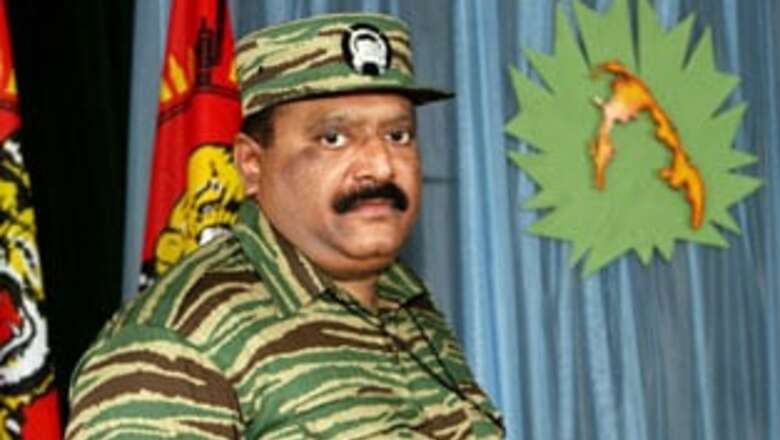
views
New Delhi: His first victims were squirrels and birds, and his first weapon a humble catapult. From such beginnings, Velupillai Prabhakaran, who died a inglorious death, grew to be the world's most shadowy and ruthless insurgent who at one time lorded over vast areas in Sri Lanka's northeast.
The over 35 years Prabhakaran spent underground building the once unknown Liberation Tigers of Tamil Eelam (LTTE) into an awesome war and terror machine transformed the Indian Ocean island from an idyllic tourist haven into a bleeding state.
His unforgiving campaign for an independent Tamil Eelam state, to be carved out of the Tamil-majority northeastern province, left nearly 90,000 dead, gave birth to a cult of suicide bombings that shook the world, and cast a long shadow on nearby India.
By the time destiny caught up with Prabhakaran on May 18, 2009, he had acquired legendary notoriety. To critics he was a megalomaniac, one who had turned assassinations into a fine art. To his admirers he was a doughty fighter, unlike Tamil leaders of an earlier era.
Driven by a worldview that Tamils could not live within Sri Lanka because the Sinhalese would never treat them as equals, Prabhakaran decreed that anyone deemed an impediment in his path needed to be done away with.
And he did that with a vengeance that was numbingly brutal, producing dread and even awe.
He had leaders of two countries killed. One was former Indian premier Rajiv Gandhi, who was assassinated when a woman strapped with explosives blew up in May 1991 while pretending to touch his feet. The other was Sri Lanka's president Ranasinghe Premadasa, torn apart at a 1993 May Day rally by a young male who had infiltrated his house a long time ago.
But none of the attributes of blood and gore that made him so ruthless was evident when he took birth in a simple middle class home in Jaffna, the Tamil heartland, on November 26, 1954.
That was when ethnic unrest was starting to engulf Sri Lanka, involving the largely Buddhist Sinhalese majority and the mainly Hindu Tamil minority.
PAGE_BREAK
Born to a disciplinarian father, who a Sri Lankan government employee, and a devout mother, Prabhakaran was the youngest of two daughters and two sons, the natural darling of the family.
His early idols were two Indian independence heroes, including Subhas Chandra Bose, who chose gun over Mahatma Gandhi's non-violence. Prabhakaran dropped out of school due to the pull of a nascent Tamil militancy. He fled his home for good in 1972 after a vicious police crackdown.
Prabhakaran's first major act of violence was the gunning down of Jaffna's Tamil mayor in 1975. The LTTE took birth the next year but remained largely unknown till it issued its first press statement in 1978.
Those were dark days for the young Prabhakaran. With the police looking for him and lacking enough hideouts, he would sail stealthily to Tamil Nadu. Money was a problem there too. There were nights when he went hungry.
In a dramatic event, the import of which was then lost, the unknown Prabhakaran was arrested--for the first and last time--in Chennai in May 1982 after trying to kill a rival. But with help from Indian politicians, he got bail and escaped to Sri Lanka to resume his bloody innings.
It was Prabhakaran's ambush of an army patrol in Jaffna in July 1983 that killed 13 soldiers and sparked off terrible anti-Tamil violence, leading to a full-blown insurgency.
Once New Delhi began clandestinely training and arming Tamil militant groups, including the LTTE, Prabhakaran shifted to Tamil Nadu and lived there for over three years while the LTTE grew and grew.
From the safety of India, Prabhakaran ordered murderous attacks in Sri Lanka. Even as he fell in love with a Jaffna University student and fathered three children, he set up a clandestine network to feed the LTTE weapons and ammunition from around the world.
Prabhakaran quit India in January 1987. When India and Sri Lanka signed a pact later that year to end Tamil separatism, he appeared to go with it but then audaciously took on the Indian Army deployed in Sri Lanka's northeast.
Prabhakaran killed at will--be they Muslims, perceived foes among Tamils, Sri Lankan leaders or Sinhalese civilians. His suicide bombers were an elite force, whose members had their last supper with him before setting out on their missions.
Even in his bunkers, Prabhakaran was a doting father, cutting cakes on his children's birthdays. He loved good food, ice cream in particular. He had a fetish for cleanliness, was paranoid about his security, and exercised regularly. He was soft spoken. He expected complete loyalty from his band of men and women. Dissenters got no mercy.
As the body count mounted in Sri Lanka, he became uncompromising vis-a-vis his goal of Tamil Eelam. He ruled Jaffna for five years until 1995. By the late 1990s, the LTTE had large parts of the island's north and east under his control.
The LTTE had by then grown into a mammoth, fearsome entity, with the trappings of a de facto state. LTTE offices spawned in numerous countries. Unable to meet its military challenge, Sri Lanka requested Norway to broker peace, leading to a truce in 2002.
But lack of mutual trust and a crippling split in the LTTE in 2004 shattered the peace. In late 2005, Prabhakaran asked Tamils to boycott the presidential polls, leading to the narrow victory of Mahinda Rajapaksa. He believed that a Sinhalese hardliner in office would help rally the Tamils.
It turned out to be his biggest blunder - after Gandhi's 1991 killing.
LTTE provocations led to war in 2006. By 2007, Colombo brought the entire eastern province under its control for the first time in several years. By 2008, better equipped and trained Sri Lankan troops began capturing territory in the north and began killing Prabhakaran's close lieutenants.
Kilinochchi, which was Prabhakaran's de facto capital, fell in January 2009. Just four months later, the man himself lay dead while trying to flee from pursuing soldiers, dropping the curtains on one of the world's longest and bloodiest insurgencies.
(The writer, M R Narayan Swamy, is the author of Inside An Elusive Mind, the only biography of Prabhakaran.)




















Comments
0 comment